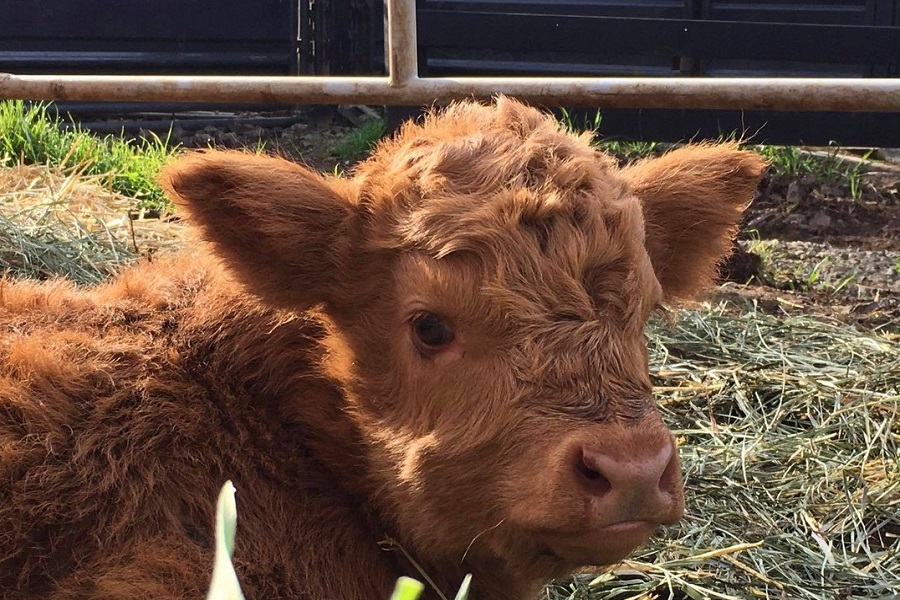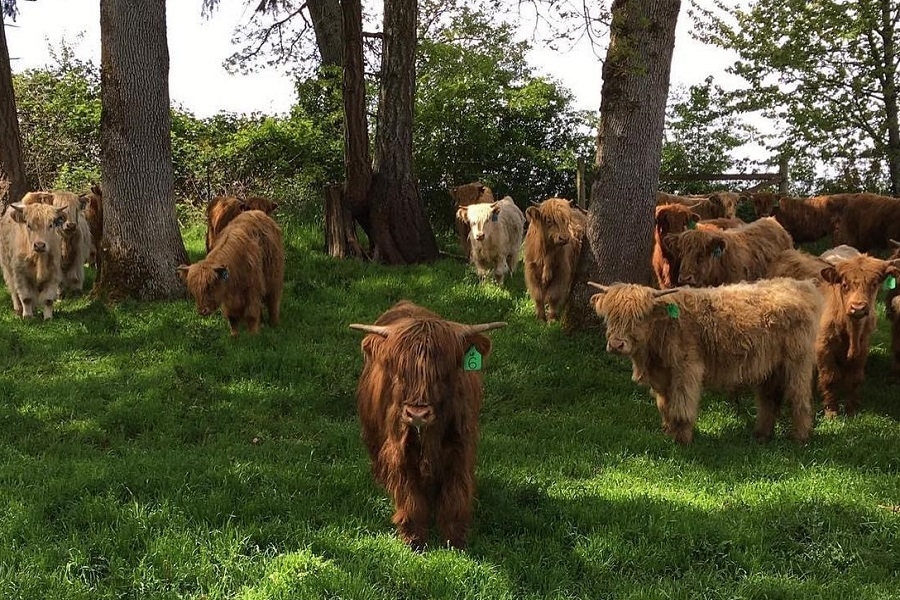Rising Meat Prices Let Small Farms and Vegan Meat Take a Bigger Bite Out of Factory Farms.
Rick Martson, owner of Martson Farm in Molalla, thought his grass-fed, farm-raised meat was the expensive option. His 300 Scottish Highland cattle take two years to mature, where cows raised on large-scale, conventional ranches take only one. That means his cattle require twice the food and twice the medicine.
Not only that, the cattle graze their whole lives, instead of eating cheap grain. But with the cost of factory-farmed meat rising, his prices aren’t so different.
“We started the pandemic being the high-priced meat, but as it wore on, we were the low-priced meat.” says Martson. “I saw other people in the commodity meats raising their beef prices for no other reason than because they could. But that didn’t seem ethical.”

A Scottish Highland calf relaxes at Martson Farm. Credit: Martson Farm
Martson says his farm is in the middle of one of its best years on record, in part because the price difference between his product and mass-manufactured meat isn’t what it used to be. With the price of his beef more comparable to the cuts customers find at the grocery store, Martson says keeping prices stable is a means of growing the customer base.
“Our competitors raising their prices has actually helped us,” says Martson.
COVID-19-spurred trends in farm-raised meat and plant-based eating are technologically and culturally outmaneuvering big meat producers. Historically, factory-farmed meat has maintained stability because of its comparably lower cost. But drought, anti-competitiveness and a vertically-integrated business model have begun to erode the price advantage. If trends continue, the meat market could face a major restructuring as smaller models find success with smaller herds — and federal support.

Scottish Highland cattle graze at Marston Farm. Credit: Martson Farm.
Meat consumption has been quietly declining in the United States. A 2020 study from Gallup found 25% of Americans are reducing their meat consumption. A report this year from Bloomberg found U.S. meat sales down 12% compared to last year — citing higher prices and trends in ethical eating as reason for the drop.
The price of meat has also gone up considerably, up approximately 25% from one year ago, according to the Food and Agriculture Organization of the United Nations’ food price index. Sales of meat substitutes, like plant-based Tofurky and Beyond Burger, have continued trending upwards.
Scott Lively, president of the Raise American, a platform for purchasing sustainably raised beef, says the pandemic has changed people’s buying habits to include more online purchasing. Lively, who divides his time between Arizona and Massachusetts, has also written a book on the industry’s complexities: For the Love of Beef: The Good, the Bad and the Future of America’s Favorite Meat came out earlier this month. (The name may be familiar to some readers, but the Scott Lively quoted in this story should not be confused with the minister of the same name who began his career campaigning against LGBT rights in Oregon in the 1980s.)
RELATED STORY: Pandemic Benefits Local Ranchers
Online platforms, Lively says, help customers them connect with local ranchers, and have accelerated trends in clean eating. In addition to enjoying premium meat, consumers are increasingly likely to make spending choices based emotional and ethical reasons, such as concern for the planet and animal welfare.
“What’s happening is consumers at all levels are really wanting to know — more than just being local — they want to know the people behind their food. I call it the ‘emotional buy,’” says Lively. “Ecommerce has really elevated our ability to shop locally. It enhances the ability to get personal with your food.”
While sales of meat have declined overall in the last year, Lively says sales direct-to-consumer meat purchasing has increased around 300% over the course of the pandemic, and the decline in sales has not been evenly distributed.
“The decline in meat consumption has been in cheap, low-processed meat. The rib eye, the tenderloin, the ‘chocolate cake’ of meat, as it were, are doing just fine,” says Lively.
Drought, consolidation and anti-competitive practices in the meat industry is fueling the rising prices. A 2009 study from Duke University found 75% of the beef in the U.S. comes from only four companies, and that consolidation in the industry has made adopting best practices more challenging. The study found factory-farmed meat has heavy environmental costs and that it is vulnerable to disruption.
Some of the challenges facing the meat industry could lessen in the near future. The Biden administration announced it would be setting aside $500 million to assist new meat processors attempting to compete with the big four.
Even if more small-scale producers make the meat industry more competitive, trends in ethical eating will likely continue. This could cause a major contraction in the market in the coming years, one which might benefit smaller farms with a loyal customer base.
For Martson, the shifting meat landscape presents an opportunity. If consumers are going to be eating meat less frequently, commodity herds like his could benefit.
“Our goal now is to get our product in as many people’s mouths as possible,” he says. “We have the opportunity to convince them this is the best beef they can buy.”
To subscribe to Oregon Business, click here.





